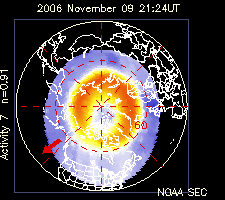The SINPO Code
The SINPO code is a way of quantifying reception conditions in a five-digit code, especially for use in reception reports to broadcasters. The code covers Signal strength, Interference (from other stations), Noise (from atmospheric conditions), Propagation disturbance (or Fading, in the SINFO code), and Overall. The code is as follows:
(S)ignal (I)nterference (N)oise (P)ropagation (O)verall 5 excellent 5 none 5 none 5 none 5 excellent 4 good 4 slight 4 slight 4 slight 4 good 3 fair 3 moderate 3 moderate 3 moderate 3 fair 2 poor 2 severe 2 severe 2 severe 2 poor 1 barely aud. 1 extreme 1 extreme 1 extreme 1 unusable
In recent years, many broadcasters have tried to steer listeners away from the SINPO code and toward the simpler SIO code. SIO deletes the extremes (1 and 5) and the noise and propagation categories, which were confusing to too many people to be useful. In sending reports to stations other than large international broadcasters who are likely to understand the codes, it is better to simply describe reception conditions in words.
Some Further Thoughts
Surface Waves over a perfectly conducting plane surface would be vertically polarised and reduce in strength by 6dB with each doubling of the distance from the transmitter. If the perfectly conducting plane was removed, the signal strength at the receiver would be unaltered as the direct wave would remain (it would no longer be cancelled out by ground reflections) Then the polarisation would not matter and vertical or horizontal polarisation would work equally well.
A very famous antenna called the Beverage makes use of the effects of an imperfect earth and responds to the low level but nearly horizontal waves that exist close to the ground. The Beverage is a very long wire aerial (several wavelengths long). Hence, Beverage aerials tend to need to be low and often work best where ground conductivity is low.
The SINPO code is a way of quantifying reception conditions in a five-digit code, especially for use in reception reports to broadcasters. The code covers Signal strength, Interference (from other stations), Noise (from atmospheric conditions), Propagation disturbance (or Fading, in the SINFO code), and Overall. The code is as follows:
(S)ignal (I)nterference (N)oise (P)ropagation (O)verall 5 excellent 5 none 5 none 5 none 5 excellent 4 good 4 slight 4 slight 4 slight 4 good 3 fair 3 moderate 3 moderate 3 moderate 3 fair 2 poor 2 severe 2 severe 2 severe 2 poor 1 barely aud. 1 extreme 1 extreme 1 extreme 1 unusable
In recent years, many broadcasters have tried to steer listeners away from the SINPO code and toward the simpler SIO code. SIO deletes the extremes (1 and 5) and the noise and propagation categories, which were confusing to too many people to be useful. In sending reports to stations other than large international broadcasters who are likely to understand the codes, it is better to simply describe reception conditions in words.
Some Further Thoughts
Surface Waves over a perfectly conducting plane surface would be vertically polarised and reduce in strength by 6dB with each doubling of the distance from the transmitter. If the perfectly conducting plane was removed, the signal strength at the receiver would be unaltered as the direct wave would remain (it would no longer be cancelled out by ground reflections) Then the polarisation would not matter and vertical or horizontal polarisation would work equally well.
A very famous antenna called the Beverage makes use of the effects of an imperfect earth and responds to the low level but nearly horizontal waves that exist close to the ground. The Beverage is a very long wire aerial (several wavelengths long). Hence, Beverage aerials tend to need to be low and often work best where ground conductivity is low.


0 Comments:
Post a Comment
<< Home